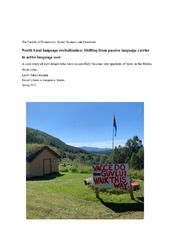| dc.contributor.advisor | Antonsen, Lene | |
| dc.contributor.advisor | Broderstad, Else Grete | |
| dc.contributor.author | Marakat, Lea O. Nilsen | |
| dc.date.accessioned | 2023-08-09T08:23:30Z | |
| dc.date.available | 2023-08-09T08:23:30Z | |
| dc.date.issued | 2023-05-13 | |
| dc.description.abstract | Language is for many a significant part of one’s identity, culture and livelihood. The strict assimilation-policy that the Norwegian state conducted against the Sámi people for over a hundred years led to a severe loss of the Sámi language in many areas. This thesis is about indigenous language revitalization in a Sámi area that suffered a great language loss because of the policy. By analyzing the interviews of eight informants from the Márka Sámi areas, who have successfully managed to go from passive language carriers to active language users, several main findings have been found. One of them being that every informant has had a strong sense of Sámi identity, which led them to form a personal motivation to want to speak Sámi.These motivations drove the informants to make an individual decision to become new speakers of North Sámi. After they had made the decision, they begun the lifelong process of maintaining and developing their language. As a reward for their efforts, the informants have been integrated into the Sámi speaking community, both in the Márka Sámi areas and in “Sápmi” overall. They are able to give their children a linguistic base and become attractive in the Sámi labor market. These findings are discussed in the light of factors that affects language revitalization by Hyltenstam, Stroud and Svonni (1999), and by Jon Todal (2007). Additionally, the concept of new speakers as an analytical tool is discussed in the framing of articles by Walsh and Lane (2014) and O'Rourke, Pujolar and Ramallo (2015). The aim of the thesis is to be a contribution to others who are striving to take back a language once lost. | en_US |
| dc.identifier.uri | https://hdl.handle.net/10037/29792 | |
| dc.language.iso | eng | en_US |
| dc.publisher | UiT Norges arktiske universitet | en_US |
| dc.publisher | UiT The Arctic University of Norway | en_US |
| dc.rights.accessRights | openAccess | en_US |
| dc.rights.holder | Copyright 2023 The Author(s) | |
| dc.rights.uri | https://creativecommons.org/licenses/by-nc-sa/4.0 | en_US |
| dc.rights | Attribution-NonCommercial-ShareAlike 4.0 International (CC BY-NC-SA 4.0) | en_US |
| dc.subject.courseID | IND-3904 | |
| dc.subject | North Sámi | en_US |
| dc.subject | Indigenous languages | en_US |
| dc.subject | New speakers | en_US |
| dc.subject | Language revitalization | en_US |
| dc.subject | Sámi dialects | en_US |
| dc.subject | Transmission of language | en_US |
| dc.subject | Sámi language centers | en_US |
| dc.subject | Márka Sámi | en_US |
| dc.title | North Sámi language revitalization: Shifting from passive language carrier to active language user. A case study of individuals who have successfully become new speakers of Sámi in the Márka Sámi areas | en_US |
| dc.type | Master thesis | en_US |
| dc.type | Mastergradsoppgave | en_US |


 English
English norsk
norsk




